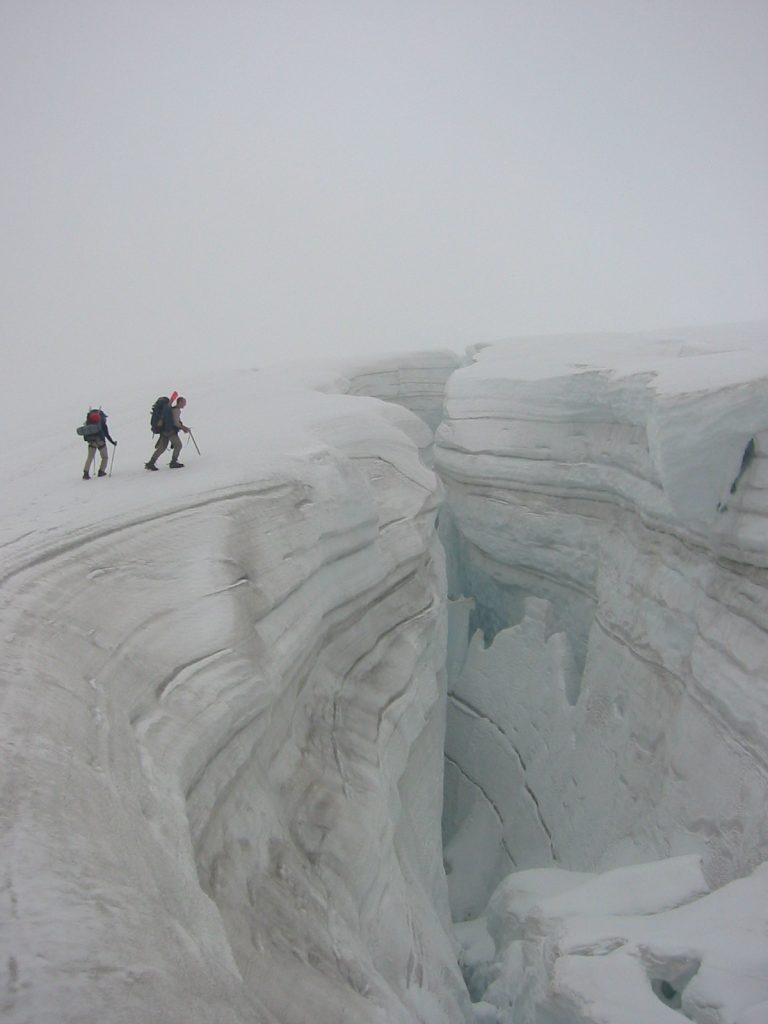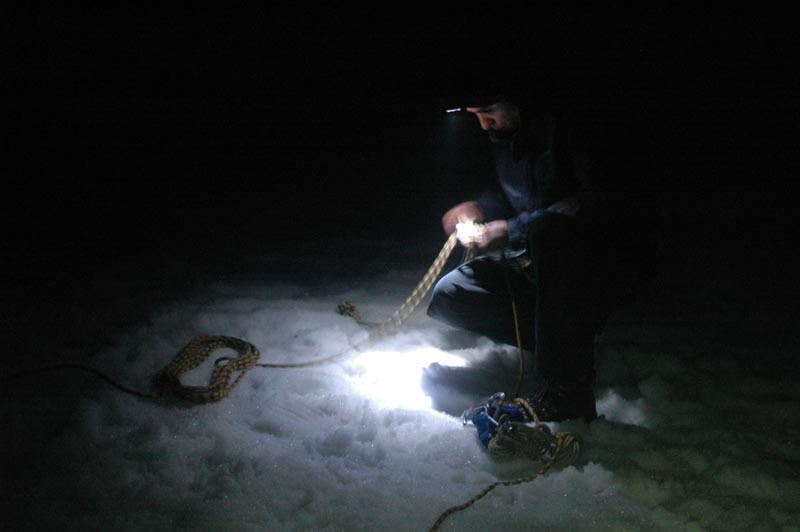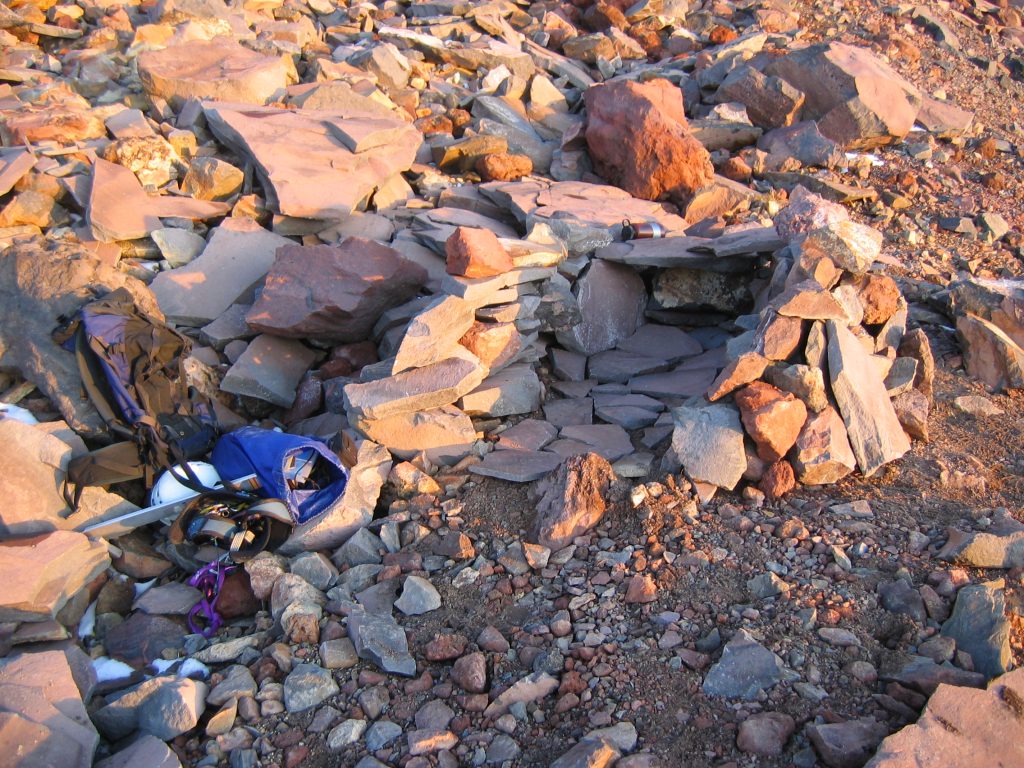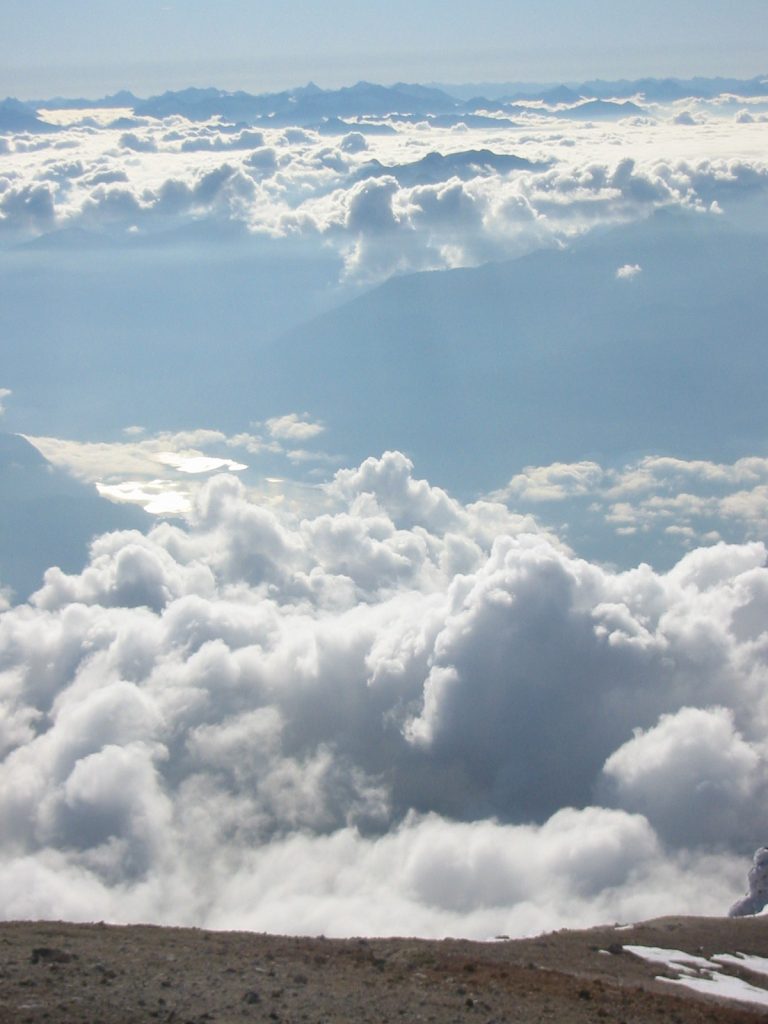North Ridge of Mt Baker
Slovak summary
Andrej Doboš pravidelne prispieva do rubriky “Prekrásna Britská Kolumbia”. V predchádzajúcich troch číslach opísal svoje zážitky z vysokohorskej turistiky a lezeckých výstupov. Dnešný príspevok je odlišný. Mount Baker je nečinná sopka, ktorá nie je v Britskej Kolumbii. Je hneď za hranicou, v USA, v štáte Washington. Dominuje však medzi kopcami na obzore vancouverského pozorovateľa a pohľad na jeho celoročnú ľadovcovú čiapku je uchvatný, hlavne v lúčoch zapadajúceho slnka. Andrejov príspevok je exkluzívnou reportážou pre náš časopis. Dej sa odohráva na prelome augusta a septembra, pred zopár týždňami v čase, keď sme pripravovali časopis do tlače. Hlavnou odlišnosťou však je to, že pokiaľ predchádzajúce príspevky boli popretkávané veselými a zábavnými postrehmi, tento príspevok opisuje udalosti na hranici tragédie. Som rád, že je Andrej medzi nami, živý a zdravý. Koniec dobrý – všetko dobré. (js)
Base Camp
Saturday afternoon of the last Labour Day weekend my climbing partner Dan and I camped at the toe of Coleman Glacier. Our final destination, Mt. Baker with its 3,285 meters, was hiding in the clouds.
As we were getting ready for the night, we talked to two participants of an American Alpine Institute group, and mentioned we were planning to climb the North Ridge of Mt. Baker on Sunday. Little did we know how critical this conversation was to be!
Climb

Sunday morning we negotiated crevasses of the lower glacier and started climbing. The ridge turned out to be a pleasant mixture of snow and ice, and early afternoon we reached the crux of the climb – a more-or-less vertical wall of ice leading onto the upper glacier.
By this time both of us were getting a bit tired, but excited about being only some 300 vertical meters below the summit.
Dan started leading the first pitch of the wall, but before he had a chance to put in his first piece of protection above the belay anchor he fell. At the time his feet were perhaps 2m above the belay station, so the fall was not too severe and as a belayer I could barely feel it. However, as he was falling, his crampon must have hit the ice and twisted his leg, and his first words after the fall were along the lines ‘… we are … in troubles … my leg is broken…’
Descent
With no means to call for help, no sleeping bags or bivys, limited amount of food and water, and weather moving in, we decided to go back. We were hoping to lower onto a relatively flat glacier below the ridge, from where I could walk to the camp to call for help.
To descend, we would set up an anchor, and I would slowly lower Dan down. He would be lying on the snow, trying to control the direction of his descent with two ice tools, occasionally screaming from pain, as his broken leg would get caught on the ice. Once the rope was out, Dan would set up a new anchor and belay me while I down-climbed to him. On steeper pitches we would set up a V-thread and I would rappel instead.
Personally, I was very concerned about stopping, as I feared that once we are not moving, Dan – having to sit on the snow the whole time – will start getting hypothermia, not to mention a shock from his injury.
Before the trip Dan insisted that we bring a stove with us. Now, in pain, climbing in the cold of the night, both of us were looking forward to stopping and making a cup of hot soup. Therefore, you can imagine our disappointment when we found out that while we had the stove, pot and fuel, we had no matches, lighter, or a flint! …and so back to the slow and painful lowering it was…
At around 4am Dan noticed headlamps of climbers on Coleman-Deming route and started signaling for help with his headlamp. It looked like the group noticed us and acknowledged Dan’s SOS.
We ended up rappelling the whole night from Sunday to Monday, and then the first half of Monday, before reaching the lowest couple of pitches above the flat glacier at some 2,560 m.
To Go or to Stay?
By this time, after 30 hours on the mountain with no sleep and minimal amount of food and water, I started having serious concerns about my ability to continue down-climbing safely. If I were to fall at the top of a pitch, I would have likely taken out any protection, and both of us would have ended up at the bottom of the cliffs.
Therefore, we decided to stay put, and either rest before continuing down, or wait for a search and rescue (SAR) team.
A number of our friends and mountaineers knew where we were and when we were expected to return, and there was no question in our minds that some of them will contact SAR when we fail to come back. At the very latest, I knew that my girlfriend would return from the Yukon Wednesday morning and call 911 then.
However, we did not have a designated person to call for help, and we failed to sign the registry at the bottom of the trail (something the SAR coordinator rightfully criticized later), and so we could only guess who would be the first to call: one of our friends, the American Alpine Institute, the group we were signaling SOS, a random climber seeing our abandoned bivys at the campsite…
Emergency Bivy
We climbed onto a small rocky ridge, found an old bivy site, and started preparing for the night, looking for water, writing a big ‘HELP’ on the snowfield next to us, and munching on a few peanuts we had left and the last couple of sips of Gatorade.

The second night was rather cold, and I spent most of it jogging and jumping in a futile effort to keep myself warm. In excruciating pain (the few painkillers we had were long gone) Dan was clenching his teeth into a cordellette, moving every couple of minutes so as to shift pain from one part of his leg to another.
The morning found us quite exhausted, thirsty, and hungry. Surprisingly, both of us were in good spirits, and we kept ourselves occupied by checking on water from the icicles, refreshing the ‘HELP!’ sign, improving our shelters, and briefly considering the option of continuing our descent.
In an attempt to light our stove, Dan tried to create sparks by scratching the rocks with crampons, scratching crampons against each other, using ice axes, knives, trying different stones…
Towards the noon we started realizing that we may have to spend yet another night on the mountain, and started building a new shelter – this time with huge flat boulders as a roof.
Search
In the meantime our hope that somebody will notice we are missing was becoming a reality: The American Alpine Institute group notified SAR that our bivys haven’t been touched for a few days. Volunteers hiked up to the camp, checked our gear, and noticed most of it is Canadian made. They also noticed my abandoned car at the trail head with a Canadian license plate, contacted the RCMP, got my phone number and tried to call me (not knowing that the phone number was for a dead cell phone in one of the bivys they just checked!). Not being able to get any response, the SAR coordinator asked the RCMP to go to my apartment to try to find out what may be happening.
A friend that I asked to dog-sit was also getting concerned: I told her I would be back on Sunday night or Monday noon. However, it was already Tuesday and I was not around. Not being a climber or hiker and unsure what to do, she contacted my other friends and the message that Dan and I haven’t returned quickly spread. Later in the afternoon our friends called 911 and filed a missing persons report.

If we had signed the trail registry, the SAR team would have had enough information to start a full-blown search and rescue operation on Tuesday morning. However, as it stood, all that the SAR team had by Tuesday early afternoon was a number of indications that two Canadian climbers may be in trouble – but not enough information to authorize the use of helicopters.
In spite of this, after a consultation with volunteer climbers, considering all ‘circumstantial evidence’ and worsening weather, the SAR coordinator decided to trust his gut instinct push the limits of bureaucracy, and expand the ‘information gathering’ by calling a US Customs and Border Patrol helicopter with a volunteer climber on board.
Rescue
And so it happened that as we were finishing our makeshift shelter on the ridge, a small search helicopter appeared in the valley. Following the climbers’ route the crew quickly noticed us, waving our red and orange jackets. As the pilot started circling above our heads, Dan was pointing at his leg, making sure the crew understands he is injured.
A few minutes later a black US NAVY Search and Rescue helicopter came, hovered above our heads, dropped a line, and lowered two marines with a stretcher. They tied Dan to the stretcher, and one of the marines with Dan were hoisted up into the helicopter. Once on board, the line came down again, and the other marine and I were lifted up to safety.

Within 10 or 15 minutes after being airlifted the helicopter landed at a hospital in Bellingham and we were taken into the Emergency Room.
Back in the Civilization
While on the mountain we were hoping somebody would help us. Now, in a US hospital, concerned about the medical bills, we found ourselves trying to push away extremely nice and very helpful doctors and nurses, not wanting any more attention than absolutely necessary to get Dan safely across the border to a Canadian hospital.
While the doctors were preparing paperwork for transfer to Canada, one of the nurses helped us to find a car rental place and I went to get a vehicle. Dan was released from the hospital, I drove us to BC, and after a short detour through VGH Emergency Room we ended up in the Royal Columbian Hospital in New Westminster.
Thursday night Dan had a surgery and is currently recovering from his injuries.
Lessons
What would I do differently next time? Come to think about it – only the obvious things everybody knows about, but sometimes we don’t do…
First of all, make sure to explicitly ask somebody to call 911 if I don’t come back by certain time, and let them know where I go. Sign all relevant trail registers.
Bring gear to call for help if necessary: radios, satellite phones, cell phones, Spot… I know – after a good dinner, while browsing the latest MEC catalogue in the comfort of one’s home, Spot or a satellite phone look very expensive. But in the middle of the night, freezing on a mountain with a broken leg (if one is lucky), those few hundred dollars suddenly have a very different value.
There is no such thing as a day-trip in the high alpine: Have at least one emergency bivy and sleeping bag in the group, a pot, fuel, and stove (and means of lighting it!) to melt water, and spare food. Some people prefer to go ‘light and fast’ but, especially after this experience, my preference is for a bigger safety margin – even if ‘heavier and slower’.
Conclusion
Finally, I’d like to say a big thanks to everybody that alerted SAR, the SAR coordinator that took his chances, the whole SAR team that took us off the mountain, helpful doctors and nurses in the hospital, and all of our friends for continuing support!
Rubrics:
(Inšpirujúce príbehy) (Potulky po svete) (Príbehy, zážitky) (Príroda) (Spomienky emigrantov)
Author:
Year:
People:
Community, organization or company:
(American Alpine Institute group) (RCMP) (Royal Columbian Hospital in New Westminster) (Search And Rescue (SAR) team) (US Customs and Border Patrol) (US NAVY Search and Rescue)
Source document:
Geo Area:
(British Columbia) (Canada) (Coleman Glacier) (Coleman-Deming route) (Mount Baker) (New Westminster) (North Ridge of Mt. Baker) (Washington) (Yukon)
